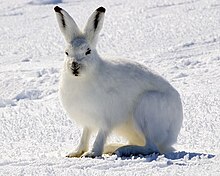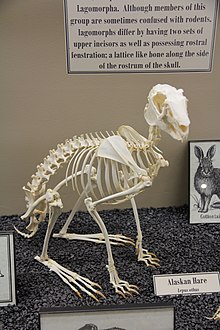
Summary
Leporidae (/ləˈpɔːrɪdiː, -daɪ/) is the family of rabbits and hares, containing over 70 species of extant mammals in all. The Latin word Leporidae means "those that resemble lepus" (hare). Together with the pikas, the Leporidae constitute the mammalian order Lagomorpha. Leporidae differ from pikas in that they have short, furry tails and elongated ears and hind legs.
| Rabbits and hares[1] | |
|---|---|

| |
| Arctic hare (Lepus arcticus) | |
| Scientific classification | |
| Domain: | Eukaryota |
| Kingdom: | Animalia |
| Phylum: | Chordata |
| Class: | Mammalia |
| Order: | Lagomorpha |
| Family: | Leporidae Fischer de Waldheim, 1817 |
| Type genus | |
| Lepus Linnaeus, 1758
| |
| Genera | |
|
Pentalagus | |

The common name "rabbit" usually applies to all genera in the family except Lepus, while members of Lepus (almost half the species) usually are called hares. Like most common names, however, the distinction does not match current taxonomy completely; jackrabbits are members of Lepus, and members of the genera Pronolagus and Caprolagus sometimes are called hares.
Various countries across all continents except Antarctica and Australia have indigenous species of Leporidae. Furthermore, rabbits, most significantly the European rabbit, Oryctolagus cuniculus, also have been introduced to most of Oceania and to many other islands, where they pose serious ecological and commercial threats.
Characteristics edit
Leporids are small to moderately sized mammals, adapted for rapid movement. They have long hind legs, with four toes on each foot, and shorter fore legs, with five toes each. The soles of their feet are hairy, to improve grip while running, and they have strong claws on all of their toes. Leporids also have distinctive, elongated and mobile ears, and they have an excellent sense of hearing. Their eyes are large, and their night vision is good, reflecting their primarily nocturnal or crepuscular mode of living.[2]
Leporids are all roughly the same shape and fall within a small range of sizes with short tails, ranging in overall length from the 21 cm (8 in) long Tres Marias cottontail to the 76 cm (30 in) long desert hare. Female leporids are almost always larger than males, which is unusual among terrestrial mammals. [3]
Both rabbits and hares are almost exclusively herbivorous (although some Lepus species are known to eat carrion), [4][5] feeding primarily on grasses and herbs, although they also eat leaves, fruit, and seeds of various kinds. Easily digestible food is processed in the gastrointestinal tract and expelled as regular feces. But in order to get nutrients out of hard to digest fiber, leporids ferment fiber in the cecum (in the GI tract) and then expel the contents as cecotropes, which are reingested (cecotrophy). The cecotropes are then absorbed in the small intestine to utilize the nutrients.[6]
The dental formula of leporids is: 2.0.3.31.0.2.3 = 28.[7]
They have adapted to a remarkable range of habitats, from desert to tundra, forests, mountains, and swampland. Some rabbits dig burrows for shelter, the exact form of which varies between species. Other rabbits do not dig burrows but use forms, usually under a bush. Hares rarely dig shelters of any kind, instead using forms, and their bodies are more suited to fast running than to burrowing.[2]
Reproduction edit
Leporids are typically polygynandrous, and some have highly developed social systems. Their social hierarchies determine which males mate. Rabbits are induced ovulators (ovulate during mating). [8]
Species nesting below ground tend to have lower predation rates and have larger litters.[9]
The gestation period in leporids varies from around 28 to 50 days, and is generally longer in the hares. This is in part because young hares (called leverets) are born precocial (eyes and ears open, fully furred), while young rabbits (called kits) are born altricial (eyes and ears closed, no fur).[2] Higher latitudes correspond to shorter gestation periods.[10] Leporids can have several litters a year, which can cause their population to expand dramatically in a short time when resources are plentiful. Gestation period and litter size correspond to predation rates as well.
Evolution edit
The oldest known leporid species date from the late Eocene, by which time the family was already present in both North America and Asia. Over the course of their evolution, this group has become increasingly adapted to lives of fast running and leaping. For example, Palaeolagus, an extinct rabbit from the Oligocene of North America, had shorter hind legs than modern forms (indicating it ran rather than hopped) though it was in most other respects quite rabbit-like.[11] Two as yet unnamed fossil finds—dated ~48 Ma (48 million yr) ago (from China) and ~53 Ma (53 million yr) ago (India)—while primitive, display the characteristic leporid ankle, thus pushing the divergence of Ochotonidae and Leporidae yet further into the past.[12]
The cladogram is from Matthee et al., 2004, based on nuclear and mitochondrial gene analysis.[13]
| Leporidae |
| |||||||||||||||||||||||||||||||||||||||||||||||||||||||||||||||
Classification edit
Family Leporidae (rabbits and hares):[1]
- Genus Pentalagus
- Amami rabbit, Pentalagus furnessi
- Genus Bunolagus
- Riverine rabbit, Bunolagus monticularis
- Genus Nesolagus
- Sumatran striped rabbit, Nesolagus netscheri
- Annamite striped rabbit, Nesolagus timminsi
- Genus Romerolagus
- Volcano rabbit, Romerolagus diazi
- Genus Brachylagus
- Pygmy rabbit, Brachylagus idahoensis
- Genus Sylvilagus
- Subgenus Tapeti
- Swamp rabbit, Sylvilagus aquaticus
- Andean tapetí, Sylvilagus andinus
- Bogota tapetí, Sylvilagus apollinaris
- Ecuadorian tapetí, Sylvilagus daulensis
- Common tapetí, Sylvilagus brasiliensis
- Fulvous tapetí, Sylvilagus fulvescens
- Dice's cottontail, Sylvilagus dicei
- Central American tapetí, Sylvilagus gabbi
- Northern tapetí, Sylvilagus incitatus
- Omilteme cottontail, Sylvilagus insonus
- Nicefor's tapetí, Sylvilagus nicefori
- Marsh rabbit, Sylvilagus palustris
- Suriname tapetí, Sylvilagus parentum
- Colombian tapetí, Sylvilagus salentus
- Santa Marta tapetí, Sylvilagus sanctaemartae
- Western tapetí, Sylvilagus surdaster
- Coastal tapetí, Sylvilagus tapetillus
- Venezuelan lowland rabbit, Sylvilagus varynaensis
- Subgenus Sylvilagus
- Desert cottontail, Sylvilagus audubonii
- Mexican cottontail, Sylvilagus cunicularis
- Eastern cottontail, Sylvilagus floridanus
- Tres Marias cottontail, Sylvilagus graysoni
- Robust cottontail, Sylvilagus holzneri
- Mountain cottontail, Sylvilagus nuttallii
- Appalachian cottontail, Sylvilagus obscurus
- New England cottontail, Sylvilagus transitionalis
- Subgenus Microlagus
- Brush rabbit, Sylvilagus bachmani
- Subgenus Tapeti
- Genus Oryctolagus
- European rabbit, Oryctolagus cuniculus
- Genus Poelagus
- Bunyoro rabbit, Poelagus marjorita
- Genus Pronolagus
- Natal red rock hare, Pronolagus crassicaudatus
- Jameson's red rock hare, Pronolagus randensis
- Smith's red rock hare, Pronolagus rupestris
- Hewitt's red rock hare, Pronolagus saundersiae
- Genus Caprolagus
- Hispid hare, Caprolagus hispidus
- Genus Lepus
- Subgenus Macrotolagus
- Antelope jackrabbit, Lepus alleni
- Subgenus Poecilolagus
- Snowshoe hare, Lepus americanus
- Subgenus Lepus
- Arctic hare, Lepus arcticus
- Alaskan hare, Lepus othus
- Mountain hare, Lepus timidus
- Subgenus Proeulagus
- Black jackrabbit, Lepus insularis
- Desert hare, Lepus tibetanus
- Tolai hare, Lepus tolai
- Subgenus Eulagos
- Broom hare, Lepus castroviejoi
- Yunnan hare, Lepus comus
- Korean hare, Lepus coreanus
- European hare, Lepus europaeus
- Manchurian hare, Lepus mandshuricus
- Ethiopian highland hare, Lepus starcki
- Subgenus Sabanalagus
- Ethiopian hare, Lepus fagani
- African savanna hare, Lepus victoriae
- Subgenus Indolagus
- Hainan hare, Lepus hainanus
- Indian hare, Lepus nigricollis
- Burmese hare, Lepus peguensis
- Subgenus Sinolagus
- Chinese hare, Lepus sinensis
- Subgenus Tarimolagus
- Yarkand hare, Lepus yarkandensis
- Incertae sedis
- Tamaulipas jackrabbit, Lepus altamirae
- Japanese hare, Lepus brachyurus
- Black-tailed jackrabbit, Lepus californicus
- White-sided jackrabbit, Lepus callotis
- Cape hare, Lepus capensis
- Corsican hare, Lepus corsicanus
- Tehuantepec jackrabbit, Lepus flavigularis
- Granada hare, Lepus granatensis
- Abyssinian hare, Lepus habessinicus
- Woolly hare, Lepus oiostolus
- Scrub hare, Lepus saxatilis
- White-tailed jackrabbit, Lepus townsendii
- Subgenus Macrotolagus
- Genus †Serengetilagus
- †Serengetilagus praecapensis
- Genus †Aztlanolagus
- †Aztlanolagus agilis
Predation edit
Predators of rabbits and hares include raccoons, snakes, eagles, canids, cats, mustelids, owls and hawks. Animals that eat roadkill rabbits include vultures and buzzards.
See also edit
References edit
- ^ a b Hoffman, R.S.; Smith, A.T. (2005). "Order Lagomorpha". In Wilson, D.E.; Reeder, D.M (eds.). Mammal Species of the World: A Taxonomic and Geographic Reference (3rd ed.). Johns Hopkins University Press. pp. 194–211. ISBN 978-0-8018-8221-0. OCLC 62265494.
- ^ a b c Chapman, J.; Schneider, E. (1984). MacDonald, D. (ed.). The Encyclopedia of Mammals. New York: Facts on File. pp. 714–719. ISBN 978-0-87196-871-5.
- ^ Ralls, Katherine (June 1976). "Mammals in Which Females are Larger Than Males". The Quarterly Review of Biology. 51 (2): 245–276. doi:10.1086/409310. PMID 785524. S2CID 25927323.
- ^ Best, Troy L.; Henry, Travis Hill (1994). "Lepus arcticus". Mammalian Species (457). American Society of Mammalogists (published 2 June 1994): 1–9. doi:10.2307/3504088. JSTOR 3504088. OCLC 46381503. S2CID 253989268.
- ^ "Snowshoe Hare". eNature: FieldGuides. eNature.com. 2007. Archived from the original on 16 January 2009. Retrieved 23 March 2008.
- ^ "Exploring a Rabbit's Unique Digestive System". Rabbits for Dummies. Retrieved 14 August 2013.
- ^ Elbroch, Mark (2006). Animal Skulls : A Guide to North American Species. Mechanicsburg, PA: Stackpole Books. pp. 249–259. ISBN 978-0-8117-3309-0.
- ^ Bell, Diana; Smith, Andrew T. (2006) [copyright 2001]. "Lagomorphs". In Macdonald, David; Norris, Sasha (eds.). The Encyclopedia of Mammals. London: The Brown Reference Group. p. 695. ISBN 0-681-45659-0.
- ^ Virgós, Emilio; Cabezas-Díaz, Sara; Blanco-Aguiar, José Antonio (1 August 2006). "Evolution of life history traits in Leporidae: a test of nest predation and seasonality hypotheses". Biological Journal of the Linnean Society. 88 (4): 603–610. doi:10.1111/j.1095-8312.2006.00646.x. ISSN 1095-8312.
- ^ Chapman, Joseph A. (1 September 1984). "Latitude and Gestation Period in New World Rabbits (Leporidae: Sylvilagus and Romerolagus)". The American Naturalist. 124 (3): 442–445. doi:10.1086/284286. JSTOR 2461471. S2CID 83584955.
- ^ Savage, R.J.G.; Long, M.R. (1986). Mammal Evolution: an illustrated guide. New York: Facts on File. pp. 128–129. ISBN 978-0-8160-1194-0.
- ^ Handwerk, Brian (21 March 2008). "Easter Surprise: World's Oldest Rabbit Bones Found". National Geographic News. National Geographic Society. Archived from the original on 22 March 2008.
- ^ Matthee, Conrad A.; et al. (2004). "A Molecular Supermatrix of the Rabbits and Hares (Leporidae) Allows for the Identification of Five Intercontinental Exchanges During the Miocene". Systematic Biology. 53 (3): 433–477. doi:10.1080/10635150490445715. PMID 15503672.


